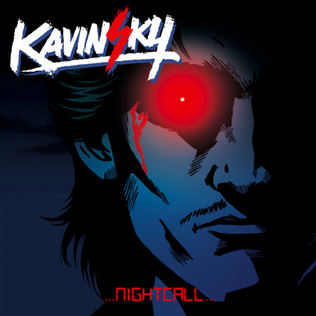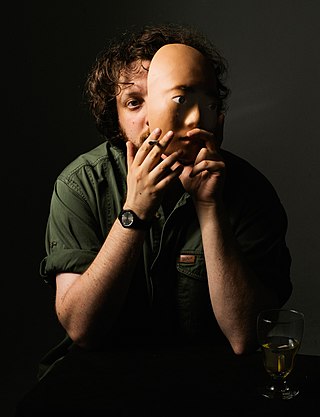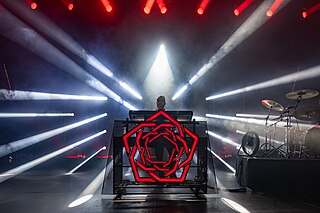
Out Run is an arcade driving video game released by Sega in September 1986. It is known for its pioneering hardware and graphics, nonlinear gameplay, a selectable soundtrack with music composed by Hiroshi Kawaguchi, and the hydraulic motion simulator deluxe arcade cabinet. The goal is to avoid traffic and reach one of five destinations.

Vincent Belorgey, known professionally as Kavinsky, is a French musician, producer, DJ, and actor. His production style is reminiscent of the electropop film soundtracks of the 1980s. Kavinsky claims that his music is inspired by thousands of movies he watched as a young boy and that he has cherry-picked the best parts from them, consolidating them into one concept. Kavinsky has been compared to many similar French house artists, including Danger and French duo Daft Punk. He achieved greater mainstream recognition after his song "Nightcall" was featured in the 2011 film Drive. His debut studio album, OutRun, was released in 2013.

"Nightcall" is a song by French electro house artist Kavinsky, released as a single in 2010. It was produced with Daft Punk's Guy-Manuel de Homem-Christo and mixed by electronic artist Sebastian. It features Lovefoxxx, lead singer of Brazilian band CSS, on vocals and includes remixes by Xavier de Rosnay, Jackson and his Computer Band and Breakbot. The track was used in the title sequence for the film Drive, directed by Nicolas Winding Refn and starring Ryan Gosling and Carey Mulligan. "Nightcall" was included on Kavinsky's debut studio album, OutRun (2013).

Daniel Lopatin, best known as Oneohtrix Point Never or OPN, is an American experimental electronic music producer, composer, singer, and songwriter. His music has utilized tropes from various musical genres and eras, sample-based composition, and complex MIDI production.

David Grellier is a French electronica musician and founder of the musical projects College (2005) and Valerie (2007). Under the stage name Mitch Silver, he is also a member of the electroclash band Sexy Sushi, active since 2004.

OutRun is the debut studio album by French electronic musician Kavinsky, released on 22 February 2013 by Record Makers, Vertigo Records and Mercury Records. Production for the album was handled primarily by Kavinsky, along with close friend and fellow French electro house artist Sebastian. The album is named after Sega's 1986 arcade game of the same name, which featured the Ferrari Testarossa.

"Odd Look" is a song recorded by French electronic musician Kavinsky featuring fellow French disk jockey SebastiAn from his album OutRun (2013). The song was co-written by the two artists and produced by the latter. It was released as a single on 6 June 2013.

Power Glove is an Australian electronic music and synthwave duo from Melbourne, Victoria, named after the Power Glove made by Mattel for the Nintendo Entertainment System. They provided the soundtrack to the 1980s-influenced retro-futuristic video game Far Cry 3: Blood Dragon. The soundtrack was met with critical acclaim.

Vaporwave is a microgenre of electronic music and a subgenre of hauntology, a visual art style, and an Internet meme that emerged in the early 2010s, and became well-known in 2015. It is defined partly by its slowed-down, chopped and screwed samples of smooth jazz, 1970s elevator music, R&B, and lounge music from the 1980s and 1990s. The surrounding subculture is sometimes associated with an ambiguous or satirical take on consumer capitalism and pop culture, and tends to be characterized by a nostalgic or surrealist engagement with the popular entertainment, technology and advertising of previous decades. Visually, it incorporates early Internet imagery, late 1990s web design, glitch art, anime, stylized Greek sculptures, 3D-rendered objects, and cyberpunk tropes in its cover artwork and music videos.
Robert Parker is a Swedish electronic musician from Stockholm, known for his synthwave works.

James Kent, known by his stage name Perturbator, is a French synthwave musician from Paris. His parents are British music critic Nick Kent, and French music journalist, Laurence Romance.

Franck Hueso, better known by his stage name Carpenter Brut, is a French darksynth artist from Poitiers, France. He has released three EPs, EP I (2012), EP II (2013) and EP III (2015), which were collected and released together as the album Trilogy (2015). He later released three additional studio albums, Leather Teeth (2018), Blood Machines OST (2020) and Leather Terror (2022), along with one live album, CarpenterBrutLive (2017). He has also contributed original music to a variety of soundtracks, both for film and video games.

Sovietwave is a subgenre of synthwave music and accompanying Internet aesthetic which originates from the former Soviet Union, primarily Russia. It is characterized by an emphasis on the technology and culture of the Soviet Union, such as the Soviet space program and retrofuturistic Soviet era architecture and art, and is an expression of nostalgia for the Soviet Union. Linguist Maria Engström described Sovietwave as the post-Soviet counterpart to vaporwave, evoking a similar nostalgic critique of the "contemporary collapse of futurity" and longing for the lost optimism of a bygone era.

Nina Boldt known mononymously and professionally as NINA is a German singer-songwriter based in London and Berlin. Her music is a fusion of Pop, New Wave, and Electronic music. She released her debut album Sleepwalking in 2018 and her follow-up album Synthian in 2020. Her third major release Control was released as an EP via Lakeshore Records and features samples from Cliff Martinez' Drive film score which ultimately began a modern revival of the cliche 1980s music, art and graphics scene.

The Rise of the Synths is a 2019 documentary film written and directed by Iván Castell and narrated by filmmaker and composer John Carpenter. The film explores the origins and growth of the electronic music genre known as synthwave, charting its rise in popularity from the underground online music scene to its recent mainstream exposure, following use in retro-themed soundtracks, notably the 2011 film Drive and more recently, the television series Stranger Things.
Irving Force is a synthwave producer from Stockholm, Sweden. He previously was a member of the black metal bands Vanhävd and Vapenlicens, before becoming interested in 80's-influenced film scores.

Laura Fares, known as LAU or Lau Fares is an Argentine singer-songwriter, drummer, and producer from Argentina, and currently based in Barcelona (Spain), after 21 years in the United Kingdom. She is also the founder of Aztec Records with Ariel Amejeiras.
Mallsoft is a vaporwave subgenre centered around shopping malls.
Dreampunk is a microgenre of electronic music characterized by its focus on cinematic ambience and field recordings, combined with various traits and techniques from electronic genres such as techno, jungle, electro, and dubstep.
Jornt Elzinga, commonly known as Cat System Corp., is a Dutch musician regarded as a vaporwave figure that originated the mallsoft subgenre. He also previously recorded as Mesektet for his dark ambient releases.
















